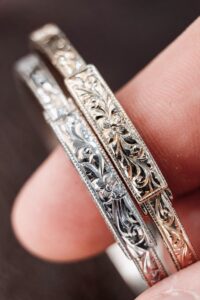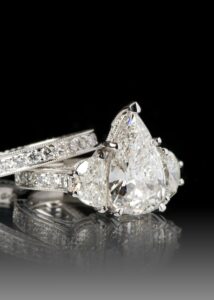The Benefits of Platinum Jewelry
Platinum is a precious metal known for its purity, resistance to tarnishing, and durability — it is more exclusive than gold. Its uniqueness makes it a sought-after material for creating exquisite, valuable, and treasured jewelry.
Why choose platinum instead of white gold? While similar in appearance to white gold — an alloy of silver, copper, zinc, and nickel — platinum is more durable and worthwhile. It’s perfect for an engagement and wedding ring and requires no replating over time. It is naturally white, straight from origination, instead of being naturally yellow (like gold) and needing to be plated to achieve the white look Additionally, platinum requires only the smallest amount to create an alloy, unlike yellow or white 14- and 18-karat gold, which comprises 58.5% to 75% gold. And unlike gold, which weakens with increased purity, platinum becomes stronger.

Designers choose platinum for numerous men’s and women’s fine jewelry pieces and styles. It’s suitable for classic to contemporary, in engagement rings, wedding rings, earrings, necklaces, and bracelets, simple or elaborate, adorned or classic. The high-quality metal offers sophisticated elegance that exudes good taste and prestige. Many consider platinum the pinnacle of craftsmanship and luxury.
What Is Platinum?
Platinum is an appealing, lustrous silver-white metal derived from some copper and nickel ores and in alluvial river sand, with 80% mined in South Africa. It is the most ductile pure metal — highly pliable without losing toughness — but less malleable than gold. Its scarcity makes it highly valuable, with just a few hundred tonnes produced yearly. Around a third is used for jewelry as a 90% to 95% alloy or 999 parts per thousand.
Beyond its aesthetics and investment value, the metal’s chemical stability makes it ideal for numerous commercial and industrial applications. These include laboratory equipment, electrodes and electrical contacts, dentistry tools, the glass industry, and as a compound in some chemotherapy drugs.
The Characteristics of Platinum
Platinum is a superior metal, one of the most stable. It’s distinctively durable and resistant to stress, tarnish, scratch, heat, and cold. These features make it highly suitable for everyday jewelry, maintaining its shine and shape long-term.
The metal also yields a striking luster, perfect for showcasing the beauty of diamonds and other brilliant gemstones, with its shimmering white shade complementing numerous colors. Additionally, platinum’s low reactivity makes it hypoallergenic for sensitive skin.

The Benefits of Platinum Jewelry
The benefits of owning and investing in the gleaming patina of platinum jewelry include the following:
- Purity — requires limited mixing with other metals for alloys
- Striking luster and color appeal
- Uncompromised malleability for unique designs
- Gemstone setting security, including bezel or tension settings
- Weight — 11% heavier than gold — with long-lasting strength and durability
- Noncorrosive and incorruptible substance
- Shape and shine retention — limited or no damage to cause depreciation
- Resistance to wear and tear — suitable for daily use
The Process of Crafting Platinum Jewelry
The natural metal comprises six platinum group metals. Three of these — palladium, iridium, and platinum — are combined to manufacture platinum jewelry. Processes include “lost wax casting,” where a model is sculpted in wax to create a vulcanized rubber mold from which the platinum piece is cast. This precise approach facilitates accuracy and detail for complex designs.
“Invisible setting” is another common technique. In this method, gemstones are set into the platinum without any supporting structure or visible prongs, yielding the appearance of an item with a “floating” gem. At the same time, the stones are entirely secure in their settings.
Platinum is also frequently used for fusion pieces. This technique combines two or more metals to create a custom appearance of color for functional strengthening purposes or aesthetic reasons.
Caring for Platinum Jewelry
Thanks to its remarkable advantages, platinum jewelry needs less maintenance than gold, silver, and other precious metals. Your platinum pieces are noncorrosive and resistant to tarnishes, scratches, and deformation. While they still require regular cleaning, they do not require the additional step of being replated. You can take care of your platinum rings and other pieces by:
-
- Storing items separately
- Removing your wedding ring or other platinum jewelry when gardening and before using harsh chemicals such as bleach
- Cleaning platinum pieces with a mild soap, warm water solution, or a dedicated product, if necessary. Use a soft toothbrush followed by a clean, dry cloth
- Having your platinum items cleaned by a jeweler biannually, especially if your jewelry includes delicate gemstones
You can confidently wear platinum jewelry daily without fear of damage or deterioration.
Add a Durable Platinum Ring to Your Diamond for a Truly Forever Wedding Band with JPratt Designs
Choosing platinum for your wedding bands or other jewelry items offers timeless beauty and class and is an excellent, enduring investment. Choosing an equally renowned jeweler is also essential. Browse JPratt Designs’ exclusive platinum custom jewelry pieces, and contact us today to schedule an appointment.
